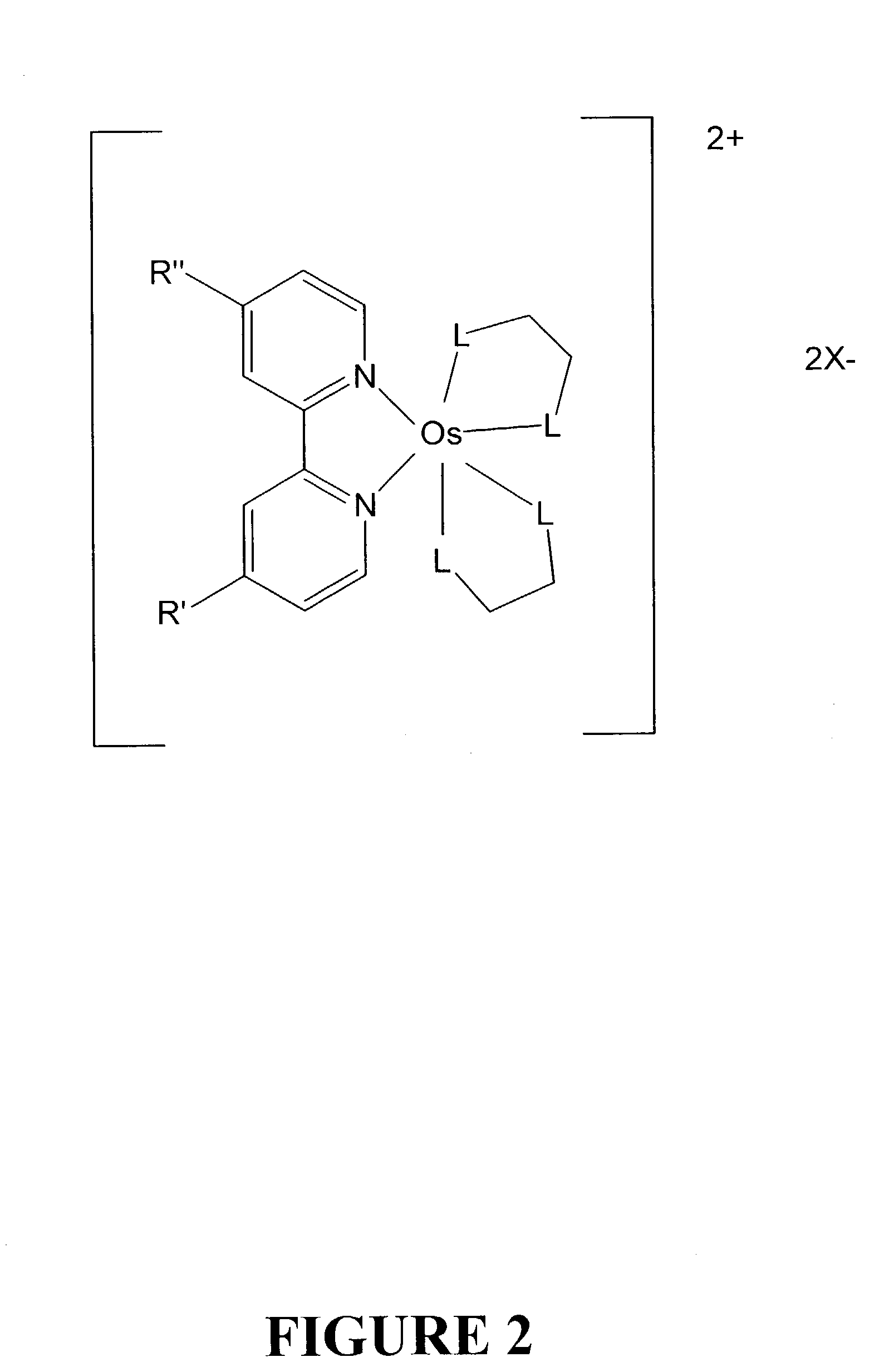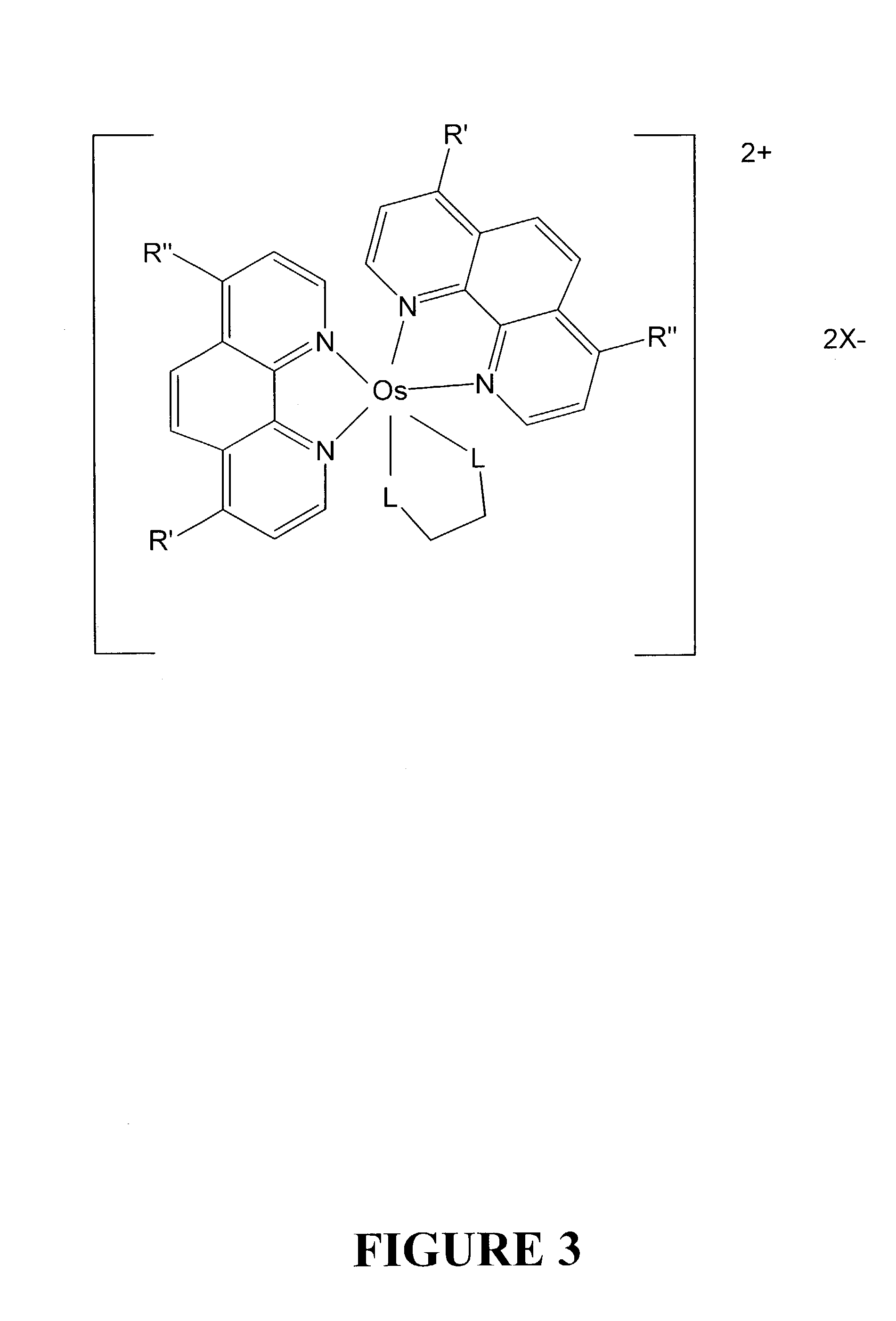Osmium complexes and related organic light-emitting devices
a technology of organic light-emitting devices and osmium complexes, which is applied in the direction of discharge tube luminescnet screens, natural mineral layered products, etc., can solve the problem of difficult to obtain strong red emission from conjugated polymers or small molecules
- Summary
- Abstract
- Description
- Claims
- Application Information
AI Technical Summary
Benefits of technology
Problems solved by technology
Method used
Image
Examples
example 1
General Methods for Osmium Complex Characterization
[0092]Elemental analyses were carried out by Oneida Research Services, Inc., Whitesboro, N.Y. UV-Vis absorption spectra were measured on a Shimadzu UV-1601 spectrophotometer. Quantitative measurements were obtained by using 1.000 cm path length quartz cells with absolute ethanol as the solvent. Electrospray mass spectroscopy was measured on either an Esquire-LC ion trap mass spectrometer (Bruker and Hewlett-Packard) or an Applied Biosystems Mariner ESI-TOF mass spectrometer. 1H NMR was carried out on a 200 MHz Bruker FT-NMR spectrometer.
[0093]Emission spectra of ethanol solutions were collected on a Perkin-Elmer LS50B fluorescence spectrophotometer. The wavelength sensitivity of the instrument was calibrated prior to measurements using a standard 20 W tungsten lamp of known output. All emission spectra were corrected to the calibration curve calculated from the known lamp output. The solutions were degassed using argon for 30 min be...
example 2
The Preparation of a Representative Bidentate Ligand (L—L): cis-1,2-Vinylenebis(diphenylarsine)
[0097]In this example, the synthesis of a bidentate ligand (L—L), cis-1,2-vinylenebis(diphenylarsine), useful in making the complexes of the invention is described.
[0098]Diphenylarsine (Organometalics, 25.00 g, 108.6 mmol) was used as received and added to 400 mL of freshly dried (sodium / benzophenone) THF. The solution was stirred under nitrogen and cooled to −78° C. using an acetone / dry ice bath. To this solution was added n-butyl lithium (1.6 M in hexane, 1.05 eq, 114.1 mmol). The solution was allowed to stir for 1 h. The acetone bath was then removed and cis-dichloroethylene (TCI-America, 10.66 g, 110.0 mmol) was added. The solution was allowed to slowly warm to 18.5° C. and react overnight. Water was added and the THF was removed by rotary evaporation under vacuum at 40° C. The water was removed by filtration and the solid material was washed with large amounts of de-ionized water. The...
example 3
The Preparation of a Representative Bipyridine Ligand (N—N): 4,4′-Bis(p-biphenyl)-2,2′-bipyridine
[0099]In this example, the synthesis of a bipyridine ligand (N—N), 4,4′-bis(p-biphenyl)-2,2′-bipyridine, useful in making the complexes of the invention is described. The procedure was an adaptation and combination of the methods reported by Haginiwa and Chase.
[0100]4,4′-Dibromo-2,2′-bipyridine (2.000 g, 6.37 mmol) and biphenyl-4-boronic acid neopentyl glycol ester (4.238 g, 15.92 mmol) were dissolved into 80 mL DMF (Aldrich). The solution was stirred for 1 h under nitrogen and tetrakis(triphenylphosphine) Pd(0) (0.191 mmol) was added. The solution was heated to 60° C. and 10 mL deoxygenated saturated potassium carbonate aqueous solution was added drop wise over a period of 5 min. The solution was then warmed to 85-95° C. The coupling was allowed to proceed under these conditions for 24 h. The solution was warmed to 115° C. and the reaction was allowed to proceed for an additional 5 h. T...
PUM
| Property | Measurement | Unit |
|---|---|---|
| Percent by mass | aaaaa | aaaaa |
| Fraction | aaaaa | aaaaa |
| Fraction | aaaaa | aaaaa |
Abstract
Description
Claims
Application Information
 Login to View More
Login to View More - R&D
- Intellectual Property
- Life Sciences
- Materials
- Tech Scout
- Unparalleled Data Quality
- Higher Quality Content
- 60% Fewer Hallucinations
Browse by: Latest US Patents, China's latest patents, Technical Efficacy Thesaurus, Application Domain, Technology Topic, Popular Technical Reports.
© 2025 PatSnap. All rights reserved.Legal|Privacy policy|Modern Slavery Act Transparency Statement|Sitemap|About US| Contact US: help@patsnap.com



